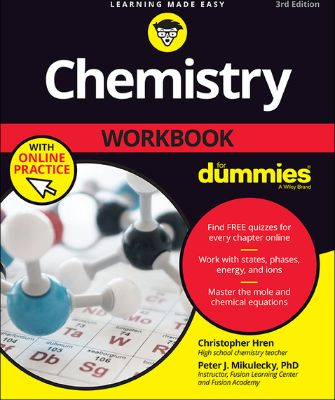
Lýsing:
Take the confusion out of chemistry with hundreds of practice problems Chemistry Workbook For Dummies is your ultimate companion for introductory chemistry at the high school or college level. Packed with hundreds of practice problems, this workbook gives you the practice you need to internalize the essential concepts that form the foundations of chemistry. From matter and molecules to moles and measurements, these problems cover the full spectrum of topics you'll see in class—and each section includes key concept review and full explanations for every problem to quickly get you on the right track.
This new third edition includes access to an online test bank, where you'll find bonus chapter quizzes to help you test your understanding and pinpoint areas in need of review. Whether you're preparing for an exam or seeking a start-to-finish study aid, this workbook is your ticket to acing basic chemistry. Chemistry problems can look intimidating; it's a whole new language, with different rules, new symbols, and complex concepts.
The good news is that practice makes perfect, and this book provides plenty of it—with easy-to-understand coaching every step of the way. Delve deep into the parts of the periodic table Get comfortable with units, scientific notation, and chemical equations Work with states, phases, energy, and charges Master nomenclature, acids, bases, titrations, redox reactions, and more Understanding introductory chemistry is critical for your success in all science classes to follow; keeping up with the material now makes life much easier down the education road.
Annað
- Höfundar: Chris Hren, Peter J. Mikulecky
- Útgáfa:3
- Útgáfudagur: 2017-03-22
- Hægt að prenta út 10 bls.
- Hægt að afrita 2 bls.
- Format:ePub
- ISBN 13: 9781119357469
- Print ISBN: 9781119357452
- ISBN 10: 1119357462
Efnisyfirlit
- Cover
- Introduction
- About This Book
- Foolish Assumptions
- Icons Used in This Book
- Beyond the Book
- Where to Go from Here
- Part 1: Getting Cozy with Numbers, Atoms, and Elements
- Chapter 1: Noting Numbers Scientifically
- Using Exponential and Scientific Notation to Report Measurements
- Multiplying and Dividing in Scientific Notation
- Using Exponential Notation to Add and Subtract
- Distinguishing between Accuracy and Precision
- Expressing Precision with Significant Figures
- Doing Arithmetic with Significant Figures
- Answers to Questions on Noting Numbers Scientifically
- Chapter 2: Using and Converting Units
- Familiarizing Yourself with Base Units and Metric System Prefixes
- Building Derived Units from Base Units
- Converting between Units: The Conversion Factor
- Letting the Units Guide You
- Answers to Questions on Using and Converting Units
- Chapter 3: Breaking Down Atoms
- The Atom: Protons, Electrons, and Neutrons
- Deciphering Chemical Symbols: Atomic and Mass Numbers
- Accounting for Isotopes Using Atomic Masses
- Answers to Questions on Atoms
- Chapter 4: Surveying the Periodic Table of the Elements
- Organizing the Periodic Table into Periods and Groups
- Predicting Properties from Periodic and Group Trends
- Seeking Stability with Valence Electrons by Forming Ions
- Putting Electrons in Their Places: Electron Configurations
- Measuring the Amount of Energy (or Light) an Excited Electron Emits
- Answers to Questions on the Periodic Table
- Chapter 1: Noting Numbers Scientifically
- Chapter 5: Building Bonds
- Pairing Charges with Ionic Bonds
- Sharing Electrons with Covalent Bonds
- Occupying and Overlapping Molecular Orbitals
- Polarity: Sharing Electrons Unevenly
- Shaping Molecules: VSEPR Theory and Hybridization
- Answers to Questions on Bonds
- Chapter 6: Naming Compounds and Writing Formulas
- Labeling Ionic Compounds and Writing Their Formulas
- Getting a Grip on Ionic Compounds with Polyatomic Ions
- Naming Molecular (Covalent) Compounds and Writing Their Formulas
- Addressing Acids
- Mixing the Rules for Naming and Formula Writing
- Beyond the Basics: Naming Organic Carbon Chains
- Answers to Questions on Naming Compounds and Writing Formulas
- Chapter 7: Understanding the Many Uses of the Mole
- The Mole Conversion Factor: Avogadro’s Number
- Doing Mass and Volume Mole Conversions
- Determining Percent Composition
- Calculating Empirical Formulas
- Using Empirical Formulas to Find Molecular Formulas
- Answers to Questions on Moles
- Chapter 8: Getting a Grip on Chemical Equations
- Translating Chemistry into Equations and Symbols
- Balancing Chemical Equations
- Recognizing Reactions and Predicting Products
- Canceling Spectator Ions: Net Ionic Equations
- Answers to Questions on Chemical Equations
- Chapter 9: Putting Stoichiometry to Work
- Using Mole-Mole Conversions from Balanced Equations
- Putting Moles at the Center: Conversions Involving Particles, Volumes, and Masses
- Limiting Your Reagents
- Counting Your Chickens after They’ve Hatched: Percent Yield Calculations
- Answers to Questions on Stoichiometry
- Chapter 10: Understanding States in Terms of Energy
- Describing States of Matter with the Kinetic Molecular Theory
- Make a Move: Figuring Out Phase Transitions and Diagrams
- Answers to Questions on Changes of State
- Chapter 11: Obeying Gas Laws
- Boyle’s Law: Playing with Pressure and Volume
- Charles’s Law and Absolute Zero: Looking at Volume and Temperature
- The Combined and Ideal Gas Laws: Working with Pressure, Volume, and Temperature
- Mixing It Up with Dalton’s Law of Partial Pressures
- Diffusing and Effusing with Graham’s Law
- Answers to Questions on Gas Laws
- Chapter 12: Dissolving into Solutions
- Seeing Different Forces at Work in Solubility
- Concentrating on Molarity and Percent Solutions
- Changing Concentrations by Making Dilutions
- Altering Solubility with Temperature
- Answers to Questions on Solutions
- Chapter 13: Playing Hot and Cold: Colligative Properties
- Portioning Particles: Molality and Mole Fractions
- Too Hot to Handle: Elevating and Calculating Boiling Points
- How Low Can You Go? Depressing and Calculating Freezing Points
- Determining Molecular Masses with Boiling and Freezing Points
- Answers to Questions on Colligative Properties
- Chapter 14: Exploring Rates and Equilibrium
- Measuring Rates
- Focusing on Factors That Affect Rates
- Measuring Equilibrium
- Answers to Questions on Rates and Equilibrium
- Chapter 15: Warming Up to Thermochemistry
- Understanding the Basics of Thermodynamics
- Working with Specific Heat Capacity and Calorimetry
- Absorbing and Releasing Heat: Endothermic and Exothermic Reactions
- Summing Heats with Hess’s Law
- Answers to Questions on Thermochemistry
- Chapter 16: Working with Acids and Bases
- Surveying Three Complementary Methods for Defining Acids and Bases
- Measuring Acidity and Basicity: pH, pOH, and KW
- Ka and Kb: Finding Strength through Dissociation
- Answers to Questions on Acids and Bases
- Chapter 17: Achieving Neutrality with Titrations and Buffers
- Concentrating on Titration to Figure Out Molarity
- Maintaining Your pH with Buffers
- Measuring Salt Solubility with Ksp
- Answers to Questions on Titrations and Buffers
- Chapter 18: Accounting for Electrons in Redox
- Oxidation Numbers: Keeping Tabs on Electrons
- Balancing Redox Reactions under Acidic Conditions
- Balancing Redox Reactions under Basic Conditions
- Answers to Questions on Electrons in Redox
- Chapter 19: Galvanizing Yourself to Do Electrochemistry
- Identifying Anodes and Cathodes
- Calculating Electromotive Force and Standard Reduction Potentials
- Coupling Current to Chemistry: Electrolytic Cells
- Answers to Questions on Electrochemistry
- Chapter 20: Doing Chemistry with Atomic Nuclei
- Decaying Nuclei in Different Ways
- Measuring Rates of Decay: Half-Lives
- Making and Breaking Nuclei: Fusion and Fission
- Answers to Questions on Nuclear Chemistry
- Chapter 21: Ten Chemistry Formulas to Tattoo on Your Brain
- The Combined Gas Law
- Dalton’s Law of Partial Pressures
- The Dilution Equation
- Rate Laws
- The Equilibrium Constant
- Free Energy Change
- Constant-Pressure Calorimetry
- Hess’s Law
- pH, pOH, and KW
- Ka and Kb
- Chapter 22: Ten Annoying Exceptions to Chemistry Rules
- Hydrogen Isn’t an Alkali Metal
- The Octet Rule Isn’t Always an Option
- Some Electron Configurations Ignore the Orbital Rules
- One Partner in a Coordinate Covalent Bond Giveth Electrons; the Other Taketh
- All Hybridized Orbitals Are Created Equal
- Use Caution When Naming Compounds with Transition Metals
- You Must Memorize Polyatomic Ions
- Liquid Water Is Denser than Ice
- No Gas Is Truly Ideal
- Common Names for Organic Compounds Hearken Back to the Old Days
UM RAFBÆKUR Á HEIMKAUP.IS
Bókahillan þín er þitt svæði og þar eru bækurnar þínar geymdar. Þú kemst í bókahilluna þína hvar og hvenær sem er í tölvu eða snjalltæki. Einfalt og þægilegt!Rafbók til eignar
Rafbók til eignar þarf að hlaða niður á þau tæki sem þú vilt nota innan eins árs frá því bókin er keypt.
Þú kemst í bækurnar hvar sem er
Þú getur nálgast allar raf(skóla)bækurnar þínar á einu augabragði, hvar og hvenær sem er í bókahillunni þinni. Engin taska, enginn kyndill og ekkert vesen (hvað þá yfirvigt).
Auðvelt að fletta og leita
Þú getur flakkað milli síðna og kafla eins og þér hentar best og farið beint í ákveðna kafla úr efnisyfirlitinu. Í leitinni finnur þú orð, kafla eða síður í einum smelli.
Glósur og yfirstrikanir
Þú getur auðkennt textabrot með mismunandi litum og skrifað glósur að vild í rafbókina. Þú getur jafnvel séð glósur og yfirstrikanir hjá bekkjarsystkinum og kennara ef þeir leyfa það. Allt á einum stað.
Hvað viltu sjá? / Þú ræður hvernig síðan lítur út
Þú lagar síðuna að þínum þörfum. Stækkaðu eða minnkaðu myndir og texta með multi-level zoom til að sjá síðuna eins og þér hentar best í þínu námi.
Fleiri góðir kostir
- Þú getur prentað síður úr bókinni (innan þeirra marka sem útgefandinn setur)
- Möguleiki á tengingu við annað stafrænt og gagnvirkt efni, svo sem myndbönd eða spurningar úr efninu
- Auðvelt að afrita og líma efni/texta fyrir t.d. heimaverkefni eða ritgerðir
- Styður tækni sem hjálpar nemendum með sjón- eða heyrnarskerðingu
- Gerð : 208
- Höfundur : 10627
- Útgáfuár : 2017
- Leyfi : 380


